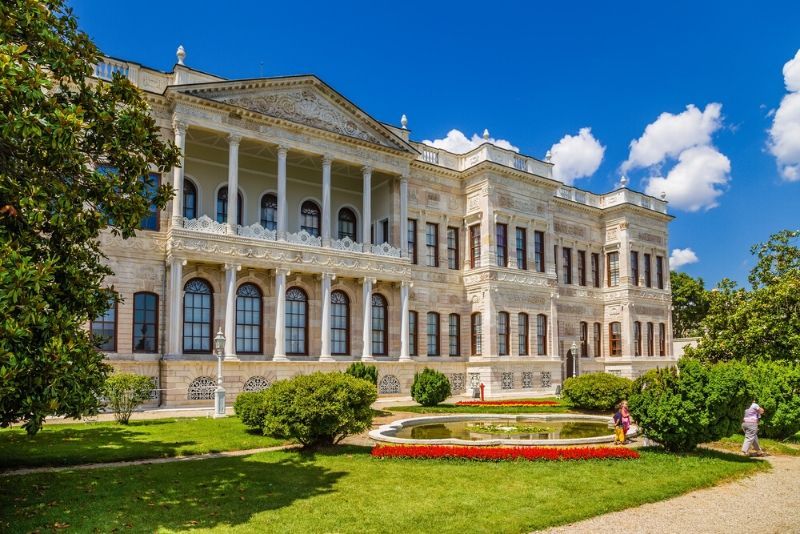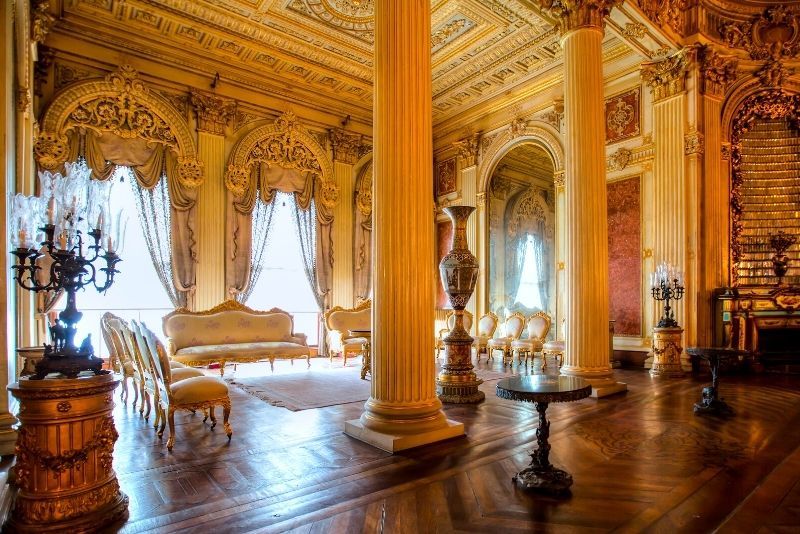Dolmabahçe Palace Skip the Line Tickets
The splendour of the Dolmabahçe Palace is something not to be missed during your visit to Istanbul. Used as an administrative headquarters during the Ottoman empire, this construction is simply the epitome of luxury.
The splendour of the Dolmabahçe Palace is something not to be missed during your visit to Istanbul. Used as an administrative headquarters during the Ottoman empire, this construction is simply the epitome of luxury.

(0/24) checking Musement...
The splendour of the Dolmabahçe Palace is something not to be missed during your visit to Istanbul. Used as an administrative headquarters during the Ottoman empire, this construction is simply the epitome of luxury.

Dolmabahçe Palace tickets will offer visitors the possibility to experience what life would have been like for the sultans and their entourages inside of the opulent walls of the palace. Marvel at the 285 lavishly decorated rooms where tons of gold, pure crystals, and handmade fine, silk carpets were used to create a truly ostentatious impression.
How much do Dolmabahçe Palace tickets cost?
There are separate entrance fees for the two areas of the palace that can be visited. These include the Selamlik and Harem.
All tickets include a tour of the palace as it is obligatory to be able to enter the attraction.
Prices are indicated and must be paid in Turkish Lira.
- Regular palace entrance fee: 60 TL (US$10.50 approx.) - includes the Selamlik
- Harem entrance fee: 40 TL (US$7 approx.) - includes only Harem
- Combined ticket: 90 TL (US$16 approx.) - includes the palace, Harem, and the Clock Museum
Are there any discounts?

Discounted tickets are available for students with a valid International Student Identity Card.
- Palace discounted entrance fee: 30 TL (US$5.25 approx.) - includes the Selamlik
- Harem discounted entrance fee: 20 TL (US$3.50 approx.) - includes only Harem
- Combined discounted ticket: 45 TL (US$8 approx.) - includes the palace, Harem, and the Clock Museum
Children aged 6 and under enter free of charge.
The Istanbul Museum Pass is not valid for entrance to the Dolmabahçe Palace.
How to book Dolmabahçe Palace tickets online?
The official website does not sell tickets online.
However, you can book guided tours of the palace, which include the entrance tickets. Some of them include only a host, who will make you skip the line and introduce the history of the palace. Other tours include the guided visit of the palace and other attractions in the city.
How do you book skip-the-line tickets?
Queues to get into the palace are infamously long and can eat up as much as two hours of your day, so the best way to skip the line is to book a tour with a fast-track ticket included.
There are two options:
- fast-track tickets: they include a host, who will allow you to jump the queue at the entrance, plus an audio guide in several languages.
- full guided tours: they include a guided visit of the palace lasting 2 or 3 hours
Both options guarantee you to get in without waiting in line.
Another option is booking a combination tour that includes various attractions in the city and allows for entrance into the palace with an organized tour so that you avoid the queues. There are plenty of available online with different attractions included.
Can I explore the palace on my own?
No, visitors are only allowed to enter the palace as part of a tour. You can join a tour at the entrance, but you will require to queue and wait until a guided tour is available.
What types of guided tours are available?
Tours are beginning every ten to twenty minutes for visitors to join at the entrance to the palace. This is because visiting the palace must be done with a tour guide. If you don't want to wait in line, you can book a tour for a specific time to optimize your trip. These tours offer fast-track entry since a predefined time slot is reserved.
- Dolmabahçe Palace Highlights Guided Tour with Fast Track Entry - Prices start from 22$ per person. This tour offers a skip-the-line ticket and a brief introduction from an English-speaking guide as well as an audio guide available in 11 languages for the rest of the tour.
- Dolmabahçe Palace: 4-hour Skip-the-Queue Guided Tour - Prices start from 60$ per person. This tour lasts 4 hours and takes place in the morning to get early access to the palace. There is an English-speaking guide who takes visitors around the Ottoman residence, explaining the history and curiosities of the site.
Are private tours worth it?
As it is compulsory to enter the palace with a guide, it is definitely worth it to find a tour that fits what you want to see. Being able to hire or join a private tour allows you to have a more personalized experience and to discover the palace at your leisure.
Another advantage of getting a private tour is that you could combine your trip to the palace with another must-see attraction in Istanbul and learn all you can about the history of this fascinating city, straddling two continents.
How to get to the Dolmabahçe Palace
From Sultanahmet
There is a tram that goes from the popular tourist area of Sultanahmet to Dolmabahçe Palace. You should take the tram to the last stop, Kabatas, which is the closest stop to the palace and from here it is a 10-minute walk.
Another option is to grab a taxi from Sultanahmet Square; however, this option can sometimes take longer due to traffic and is more costly.
From Besiktas
From Besiktas, visitors can choose any of several buses that pass by the Dolmabahçe Palace and find themselves right at the entrance with one short bus ride.
From Taksim
From Taksim, travellers can either take any of the buses travelling in the direction of the palace, walk downhill from Taksim to Kabatas (the closest tram stop) which will take approximately 15 minutes, use the funicular railway, or a taxi from Taksim Square.
From Karakoy
The cruise port in Istanbul is called Karakoy. It is close to the Galata Tower. It is located 3km from the palace. From here, it is possible to get a taxi which should take approximately 6 minutes to get to the palace entrance.
What are the opening hours?
The palace is open from 9am to 4pm on Tuesday, Wednesday, and Friday to Sunday. It is closed on Mondays and Thursdays and can sometimes be closed due to special occasions or holidays.
The palace can also be closed due to excessive demand as there is a limit on the number of visitors allowed in the palace daily.
Are there any combo tickets or tours, including other attractions?
Although many tourist attractions in Istanbul offer the possibility of free or discounted entrance using the combined Istanbul Museum Pass, unfortunately, the Dolmabahçe Palace is not included and must be paid for separately.
However, there are various tours available that offer the palace visit included, and even add fast-track entrance to avoid the queues.
Bosphorus Full-Day Sightseeing Tour: Golden Horn and Bosphorus Cruise, Spice Bazaar, Camlica Hill and Dolmabahçe Palace
Prices starting from 80$ per person. This tour lasts 8 hours and provides a full-day sightseeing tour including private, luxury transport and an English-speaking guide. Beginning with a tour of the Spice Bazaar, before climbing aboard a cruise of the Bosphorus Strait and Golden Horn, and then heading on to an exquisite 3-course lunch.
The afternoon begins with a coach climb to the peak of Camlica Hill to enjoy the spectacular vistas and taker a short walk over the Bosphorus Bridge to end the day with a guided tour of the Dolmabahçe Palace.
Dolmabahçe Palace, Pierre Loti Hill & Bosphorus Cruise
Prices start from 95$ per person. This tour lasts 8 hours and offers a skip-the-line ticket with an English-speaking guide. The guide takes visitors to tour the Dolmabahçe Palace before having lunch at a local restaurant. Then it is on to a cable car ride up to Pierre Loti Hill to get a glimpse of some impressive views and finally, tourists will be taken on a 90-minute ferry cruise along the Bosphorus river.
Istanbul Silver Combo Day Tour with Hagia Sophia, Blue Mosque and Dolmabahçe Palace
Prices start from 79$ per person. This tour lasts 8 hours and is available daily with an English, French, Spanish or German-speaking guide.
The guide begins with a visit to the Sultan Ahmet Center in the Old City, followed by the Hagia Sophia Church, the Blue Mosque, and the Hippodrome. From here the tour takes a trip to the Grand Covered Bazaar, before having lunch at a local Turkish restaurant, spends the afternoon with a tour of the Dolmabahçe Palace and ends with a beautiful panoramic view from Çamlica Hill.
When is it best to visit?
As daily visitor numbers are limited and the palace easily attracts these 3,000 tourists on weekends and holidays, it is recommended to organize your visit for midweek. It will still be necessary to queue on many days if a skip the line ticket is not purchased in advance.
What can you see inside Dolmabahçe Palace?
The palace itself inset within gardens and divided into 3 separate sections, known as the Selamlik or Mabeyn-i Hümayun, the Harem-i Hümayun, and the Muayede Salonu. These divisions allow today's visitors to get a real feel for palace life in the Ottoman era.
The Selamlik or Mabeyn-i Hümayun is the area reserved for administrative apartments, where men would have stayed on visits and business would have been conducted. The Harem-i Húmayun served as the private residence of the Sultan and his family. Finally, between the two, the Muayede Salonu was built as a ceremonial hall with a dome reaching 36 meters.
There are also other parts of the palace open to be explored, while other buildings have been demolished. Despite no longer being complete, the palace still manages to take visitors by surprise with the glamorous decor and impressive furnishings.
What is the history behind the Dolmabahçe Palace?
The home of Sultan Abdülmecid I as well as 5 other sultans, the Dolmabahçe Palace - dolma bahçe - literally meaning filled-in garden, is a lavish building, completed in 1854. Located in the Besiktas district in Istanbul, on the European side of the Bosphorus, this ostentatious construction saw the end of the Ottoman era and the beginning of a Republic.
Built on the site of a royal park and costing five million Ottoman gold lira, the Dolmabahçe Palace was intended to rival stylish contemporary palaces throughout Europe. Abdülmecit wanted to leave the medieval Ottoman style behind and use the new luxurious premises as the headquarters for the Ottoman empire. However, as the dynasty became bankrupt, in no small part to the construction of the palace, the empire finally faded and gave way to the Turkish Republic, which allowed the palace to become a presidential residence. It was then the death place of Mustafa Kemal Atatürk in 1938.
Nowadays, the Dolmabahçe Palace is under the responsibility of the Grand National Assembly of Turkey and is open to tourists all year round. It is the biggest palace in the country with a divided style, including influences from Neoclassicism, Baroque, and traditional Ottoman architecture.
